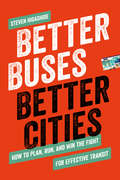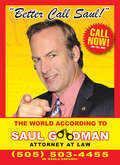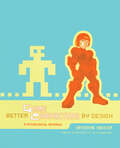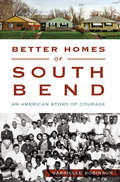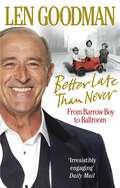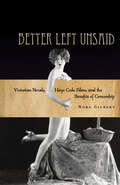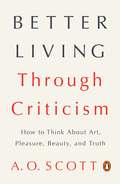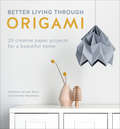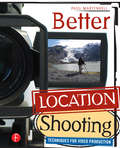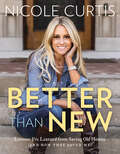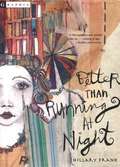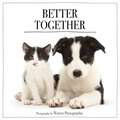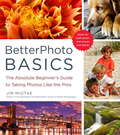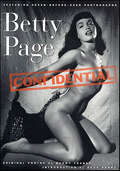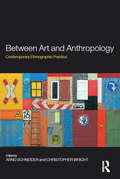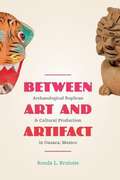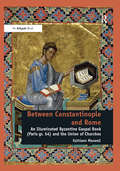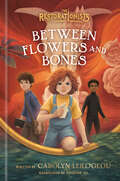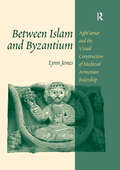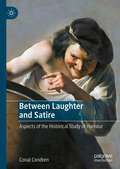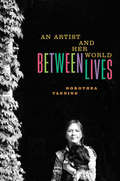- Table View
- List View
Better Buses, Better Cities: How to Plan, Run, and Win the Fight for Effective Transit
by Steven HigashideImagine a bus system that is fast, frequent, and reliable—what would that change about your city?Buses can and should be the cornerstone of urban transportation. They offer affordable mobility and can connect citizens with every aspect of their lives. But in the US, they have long been an afterthought in budgeting and planning. With a compelling narrative and actionable steps, Better Buses, Better Cities inspires us to fix the bus.Transit expert Steven Higashide shows us what a successful bus system looks like with real-world stories of reform—such as Houston redrawing its bus network overnight, Boston making room on its streets to put buses first, and Indianapolis winning better bus service on Election Day. Higashide shows how to marshal the public in support of better buses and how new technologies can keep buses on time and make complex transit systems understandable.Higashide argues that better bus systems will create better cities for all citizens. The consequences of subpar transit service fall most heavily on vulnerable members of society. Transit systems should be planned to be inclusive and provide better service for all. These are difficult tasks that require institutional culture shifts; doing all of them requires resilient organizations and transformational leadership.Better bus service is key to making our cities better for all citizens. Better Buses, Better Cities describes how decision-makers, philanthropists, activists, and public agency leaders can work together to make the bus a win in any city.
Better Call Saul: The World According to Saul Goodman
by David StubbsWelcome lawbreakers!Injured on the job?Involved in a traffic accident?Confessed to a homicide?"Better Call Saul!"Call risk free now! (505) 503-4455This is your official guide to the world of Saul Goodman
Better Game Characters by Design: A Psychological Approach
by Katherine IsbisterGames are poised for a major evolution, driven by growth in technical sophistication and audience reach. Characters that create powerful social and emotional connections with players throughout the game-play itself (not just in cut scenes) will be essential to next-generation games. However, the principles of sophisticated character design and interaction are not widely understood within the game development community. Further complicating the situation are powerful gender and cultural issues that can influence perception of characters. Katherine Isbister has spent the last 10 years examining what makes interactions with computer characters useful and engaging to different audiences. This work has revealed that the key to good design is leveraging player psychology: understanding what's memorable, exciting, and useful to a person about real-life social interactions, and applying those insights to character design. Game designers who create great characters often make use of these psychological principles without realizing it. Better Game Characters by Design gives game design professionals and other interactive media designers a framework for understanding how social roles and perceptions affect players' reactions to characters, helping produce stronger designs and better results.
Better Homes and Gardens Kitchen and Bath Renovation Guide (Better Homes and Gardens Home)
by Better Homes and GardensThis essential resource will walk homeowners through the decision-making process for a kitchen or bath renovation to create the perfect space This indispensable reference covers everything homeowners need to know about making over the two rooms that yield the most resale value. Information is included for all stages of a kitchen or bath remodel, from inspiring before-and-after images to tips on getting started, with easy-to-read lists and sidebars on topics such as setting a budget and hiring professionals. Chapters highlight floor plan ideas, decorating styles, storage solutions, and lifestyle design choices. Plus, a handy shopping guide helps renovators choose key products, from kitchen cabinetry and cooktops to bathroom sinks and lighting. Complete with an appendix of checklists, this go-to guide is perfect for homeowners ready to update their spaces as well as those just looking for new ideas for renovations in the future.
Better Homes of South Bend: An American Story of Courage (American Heritage)
by Gabrielle RobinsonIn 1950, a group of African American workers at the Studebaker factory in South Bend met in secret. Their mission was to build homes away from the factories and slums where they were forced to live. They came from the South to make a better life for themselves and their children, but they found Jim Crow in the North as well. The meeting gave birth to Better Homes of South Bend, and a triumph against the entrenched racism of the times took all their courage, intelligence and perseverance. Author Gabrielle Robinson tells the story of their struggle and provides an intimate glimpse into a part of history that all too often is forgotten.
Better Late Than Never: From Barrow Boy to Ballroom
by Len GoodmanBetter Late Than Never is the extraordinary true story of how a man born into poverty in London's East End went on to find stardom late in life when he was chosen to be head judge on BBC1's Strictly Come Dancing. Len Goodman tells all about his new-found fame, his experiences on Strictly Come Dancing, and also on the no.1 US show Dancing with the Stars and his encounters with the likes of Heather Mills-McCartney and John Sergeant. But the real story is in his East End roots. And Len's early life couldn't be more East End. The son of a Bethnal Green costermonger he spent his formative years running the fruit and veg barrow and being bathed at night in the same water Nan used to cook the beetroot. There are echoes of Billy Elliot too. Though Len was a welder in the London Docks, he dreamt of being a professional footballer, and came close to making the grade had he not broken his foot on Hackney Marshes. The doctor recommended ballroom dancing as a light aid to his recovery. And Len, it turned out, was a natural. At first his family and work mates mocked, but soon he had made the final of a national competition and the welders descended en masse to the Albert Hall to cheer him on. With his dance partner, and then wife Cheryl, Len won the British Championships in his late twenties and ballroom dancing became his life. Funny and heart-warming, Len Goodman's autobiography has all the honest East End charm of Tommy Steele, Mike Read or Roberta Taylor.
Better Left Unsaid: Victorian Novels, Hays Code Films, and the Benefits of Censorship
by Nora GilbertBetter Left Unsaidis in the unseemly position of defending censorship from the central allegations that are traditionally leveled against it. Taking two genres generally presumed to have been stymied by the censor's knife--the Victorian novel and classical Hollywood film--this book reveals the varied ways in which censorship, for all its blustery self-righteousness, can actually be good for sex, politics, feminism, and art. As much as Victorianism is equated with such cultural impulses as repression and prudery, few scholars have explored the Victorian novel as a "censored" commodity--thanks, in large part, to the indirectness and intangibility of England's literary censorship process. This indirection stands in sharp contrast to the explicit, detailed formality of Hollywood's infamous Production Code of 1930. In comparing these two versions of censorship, Nora Gilbert explores the paradoxical effects of prohibitive practices. Rather than being ruined by censorship, Victorian novels and Hays Code films were stirred and stimulated by the very forces meant to restrain them.
Better Living Through Criticism
by A. O. ScottThe New York Times film critic shows why we need criticism now more than everFew could explain, let alone seek out, a career in criticism. Yet what A.O. Scott shows in Better Living Through Criticism is that we are, in fact, all critics: because critical thinking informs almost every aspect of artistic creation, of civil action, of interpersonal life. With penetrating insight and warm humor, Scott shows that while individual critics--himself included--can make mistakes and find flaws where they shouldn't, criticism as a discipline is one of the noblest, most creative, and urgent activities of modern existence.Using his own film criticism as a starting point--everything from his infamous dismissal of the international blockbuster The Avengers to his intense affection for Pixar's animinated Ratatouille--Scott expands outward, easily guiding readers through the complexities of Rilke and Shelley, the origins of Chuck Berry and the Rolling Stones, the power of Marina Abramovich and 'Ode on a Grecian Urn.' Drawing on the long tradition of criticism from Aristotle to Susan Sontag, Scott shows that real criticism was and always will be the breath of fresh air that allows true creativity to thrive. "The time for criticism is always now," Scott explains, "because the imperative to think clearly, to insist on the necessary balance of reason and passion, never goes away."From the Hardcover edition.
Better Living Through Origami: 20 Creative Paper Projects for a Beautiful Home
by Nellianna van den Baard Kenneth VeenenbosTake papercraft to a new creative level and turn your home into a designer haven with this DIY interiors book by Dutch design duo Studio Snowpuppe. Learn how to create 20 items of sustainable home decor using simple, mindful paper folding and manipulation techniques, and then show off your DIY creations at the heart of your home. Step-by-step illustrations will guide you through the projects, which include beautiful lampshades, creative wall art ideas, an ingenious clock, pretty garlands and decorations, unique vases, candle holders, plant holders, decorative bowls and more--all with a stylish modern aesthetic. Using readily available paper and card stock, you can create some stunning designer accents for your home for a fraction of the cost of store-bought versions.
Better Location Shooting: Techniques for Video Production
by Paul MartingellLocation filming is growing in popularity with the abundance of affordable cameras. You don't need a studio, a broadcast truck, or even extensive knowledge of how to use a 16mm film camera--all you need is a digital camera, and you can take your job on the road and shoot wherever action is happening! This book will give you the knowledge and confidence you need to take your on-location shooting skills to the next level. Better Location Filming is packed with the things you will need to know to have great results while shooting your documentary, interview, sporting event, fashion or glamour event, or current affairs/news show. Beyond introductory techniques, the author will tell you how to plan, troubleshoot, handle legal requirements and issues, and of course - he'll teach you all about location filming equipment. Practical and filled with hands-on pointers, this book is perfect for working and aspiring film & video professionals seeking a leg up in their careers. As a bonus, advanced tips are included for novices who are ready to take shooting techniques to the next level.
Better Than New: Lessons I've Learned from Saving Old Homes (and How They Saved Me)
by Nicole CurtisA New York Times and USA Today Bestseller For the first time, Nicole Curtis, the star of the megahit HGTV and DIY Network show Rehab Addict, reveals her private struggles, her personal victories, and the inspiring lessons we can all learn from them. Nicole Curtis is the tough, soulful, charismatic dynamo who for the past twenty years has worked tirelessly to restore historical houses, often revitalizing neighborhoods in the process. And also, in the process, drawing millions of fans to her television show, Rehab Addict, where they follow each step of the hard work and singular vision that transform the seemingly lost cause of a run-down building into a beautifully restored home. But there is so much more to this self-taught expert and working mom. With hersignature irresistible honesty and energy, Curtis writes about a project that every reader will find compelling: how she rehabbed herself. Better Than New reveals what’s not seen on TV—Curtis’s personal battles and her personal triumphs, her complicated relationships, her life as a single mother, the story of how she got started remodeling houses, and the consuming ins and outs of producing a megahit television show while keeping up with two kids, two rescue dogs, and countless tasks on her home renovation punch lists. Followers of the show will get an inside look at some of her most famous restorations, including the Dollar house, the Minnehaha house, the Campbell Street project, and the Ransom Gillis mansion. Part inspirational memoir and part self-help guide, Better Than New is a journey ineight chapters—each pinned to the story of a house that Curtis has remodeled, each delivering a hard-fought lesson about life—that takes readers to the place we all want to be: home.
Better Than Running at Night
by Hillary FrankHaving left behind the melodrama of her solitary high school days-and the beheaded martyrs in her paintings-Ellie arrives at the New England College of Art and Design. Looking forward to the opportunity to recreate herself and her art, she begins her first day by dirty dancing with the Devil. Then she makes out with him. Ellie soon learns a lot about herself in this story about independence, trust, and boys.
Better Things: Materials for Sustainable Product Design
by Daniel LidenHow often have you seen a label on a product proclaiming it to be made from 'recycled material', 'bioplastic' or similar, without it giving any details of the concrete environmental benefits? What do these terms really mean? A drive for greater transparency and demonstrable environmental benefits is happening in product design, through emerging legislation and standards, and consumer demand for more sustainable products and unambiguous marketing. In Better Things: Materials for Sustainable Product Design, Daniel Liden seeks to tackle the lazy 'greenwashing' terminology we see every day, providing a guide for product designers, manufacturers and consumers wishing to make better and more informed decisions about materials. The book comprises six chapters devoted to material categories - plastics, textiles, metals, ceramics and glass, wood and paper - and a seventh chapter covering emerging sustainable technologies. Each chapter includes interviews with industry experts, as well as photos, diagrams, environmental impact data, general material properties and more.
Better Things: Materials for Sustainable Product Design
by Daniel LidenHow often have you seen a label on a product proclaiming it to be made from 'recycled material', 'bioplastic' or similar, without it giving any details of the concrete environmental benefits? What do these terms really mean? A drive for greater transparency and demonstrable environmental benefits is happening in product design, through emerging legislation and standards, and consumer demand for more sustainable products and unambiguous marketing. In Better Things: Materials for Sustainable Product Design, Daniel Liden seeks to tackle the lazy 'greenwashing' terminology we see every day, providing a guide for product designers, manufacturers and consumers wishing to make better and more informed decisions about materials. The book comprises six chapters devoted to material categories - plastics, textiles, metals, ceramics and glass, wood and paper - and a seventh chapter covering emerging sustainable technologies. Each chapter includes interviews with industry experts, as well as photos, diagrams, environmental impact data, general material properties and more.
Better Together: Life Is Best with a Friend Like You
by Zondervan Warren PhotographicWouldn't life be boring if we were all exactly the same? And although each of us is unique, we're really not so different after all. And it's our differences that truly make us Better Together.Better Together combines adorable photos of unlikely animal pairs alongside poignant quotes on topics for friends of all stripes on subjects such as love, respect, and compassion. Memorable, wise words alongside sweet photography beautifully and humorously communicate the truth about and magic of friendship—that although we may not be exactly the same, we're really not so different after all.Quotes from George Washington to Bono focus on friendship, unity, strength, and on harmony between people with diverse viewpoints, lifestyles, or beliefs and include inspiring quotes such as: "Do I not destroy my enemies when I make them my friends?" -Abraham Lincoln"Friendship is born at that moment when one person says to another: 'What! You too? I thought I was the only one.'" -C. S. Lewis"'Stay' is a charming word in a friend's vocabulary." -Louisa May Alcott "I would rather walk with a friend in the dark than walk alone in the light." -Helen KellerBetter Together is full of reminders of the very best things about friendship and is the perfect way to tell someone you love: "Life is best with a friend like you."
BetterPhoto Basics: The Absolute Beginner's Guide To Taking Photos Like A Pro
by Jim MiotkeAbsolutely anyone can take better photos! If you can press a button, you can take great pictures. It's as simple as that. Jim Miotke, founder of the popular online photography school BetterPhoto.com, shares tips and tricks to improve your photos right away, no matter what camera you're using. Too busy to read a book? No problem--flip to any page for an instant tip to use right away! Learn to compose knockout shots, make the most of indoor and outdoor light, and photograph twenty popular subjects, from sunsets and flowers to a family portrait. Those who want to go further get tips on controlling exposure and the secrets behind ten advanced creative techniques. And everyone will appreciate Jim's breakdown of easy fixes to make in Photoshop. No matter what your level of experience, you'll be amazed how easy it is to start taking photos like the pros.
Betting on Macau: Casino Capitalism and China's Consumer Revolution (Globalization and Community #35)
by Tim SimpsonA comprehensive look into how Macau&’s recent decades of gambling-related growth produced one of the wealthiest territories on the planetBetting on Macau delves into the radical transformation of what was formerly the last remaining European territory in Asia, returned to the People&’s Republic of China in 1999 after nearly half a millennium of Portuguese rule. Examining the unprecedented scale of its development and its key role in China&’s economic revolution, Tim Simpson follows Macau&’s emergence from historical obscurity to become the most profitable casino gaming locale in the world. Identified as a UNESCO World Heritage Site and renowned for its unique blend of Chinese and Portuguese colonial-era architecture, contemporary Macau has metamorphosed into a surreal, hypermodern urban landscape augmented by massive casino megaresorts, including two of the world&’s largest buildings. Simpson situates Macau&’s origins as a strategic trading port and its ensuing history alongside the emergence of the global capitalist system, charting the massive influx of foreign investment, construction, and tourism in the past two decades that helped generate the territory&’s enormous wealth. Presented through a cross section of postcolonial studies and social theory with extensive insight into the global gambling industry, Betting on Macau uncovers the various roots of the territory&’s lucrative casino capitalism. In turn, its trenchant analysis provides a distinctive view into China&’s broader project of urbanization, its post-Mao economic reforms, and the continued rise of its consumer culture.
Betty Page Confidential: Featuring Never-Before Seen Photographs
by Stan Corwin ProductionsCurvaceous, friendly and wholesome-looking, Playboy pinup Betty Page was the perfect complement to the still-innocent fantasies of young men during the Eisenhower years. Betty Page Confidential includes a biography of the reclusive goddess, an official Betty Page trivia quiz and 100 photos.Betty Page Confidential is the ultimate book on this 1950s icon.
Between Art and Anthropology: Contemporary Ethnographic Practice
by Arnd Schneider; Christopher WrightBetween Art and Anthropology provides new and challenging arguments for considering contemporary art and anthropology in terms of fieldwork practice. Artists and anthropologists share a set of common practices that raise similar ethical issues, which the authors explore in depth for the first time. The book presents a strong argument for encouraging artists and anthropologists to learn directly from each other's practices 'in the field'. It goes beyond the so-called 'ethnographic turn' of much contemporary art and the 'crisis of representation' in anthropology, in productively exploring the implications of the new anthropology of the senses, and ethical issues, for future art-anthropology collaborations. The contributors to this exciting volume consider the work of artists such as Joseph Beuys, Suzanne Lacy, Marcus Coates, Cameron Jamie, and Mohini Chandra. With cutting-edge essays from a range of key thinkers such as acclaimed art critic Lucy R. Lippard, and distinguished anthropologists George E. Marcus and Steve Feld, Between Art and Anthropology will be essential reading for students, artists and scholars across a number of fields.
Between Art and Artifact: Archaeological Replicas and Cultural Production in Oaxaca, Mexico
by Ronda L. BrulotteOaxaca is internationally renowned for its marketplaces and archaeological sites where tourists can buy inexpensive folk art, including replicas of archaeological treasures. Archaeologists, art historians, and museum professionals sometimes discredit this trade in "fakes" that occasionally make their way to the auction block as antiquities. Others argue that these souvenirs represent a long cultural tradition of woodcarving or clay sculpting and are "genuine" artifacts of artisanal practices that have been passed from generation to generation, allowing community members to preserve their cultural practices and make a living. Exploring the intriguing question of authenticity and its relationship to cultural forms in Oaxaca and throughout southern Mexico, Between Art and Artifact confronts an important issue that has implications well beyond the commercial realm. Demonstrating that identity politics lies at the heart of the controversy, Ronda Brulotte provides a nuanced inquiry into what it means to present "authentic" cultural production in a state where indigenous ethnicity is part of an awkward social and racial classification system. Emphasizing the world-famous woodcarvers of Arrazola and the replica purveyors who come from the same community, Brulotte presents the ironies of an ideology that extols regional identity but shuns its artifacts as "forgeries. " Her work makes us question the authority of archaeological discourse in the face of local communities who may often see things differently. A departure from the dialogue that seeks to prove or disprove "authenticity," Between Art and Artifact reveals itself as a commentary on the arguments themselves, and what the controversy can teach us about our shifting definitions of authority and authorship.
Between Constantinople and Rome: An Illuminated Byzantine Gospel Book (Paris gr. 54) and the Union of Churches
by Kathleen MaxwellThis is a study of the artistic and political context that led to the production of a truly exceptional Byzantine illustrated manuscript. Paris, Bibliothèque Nationale de France, codex grec 54 is one of the most ambitious and complex manuscripts produced during the Byzantine era. This thirteenth-century Greek and Latin Gospel book features full-page evangelist portraits, an extensive narrative cycle, and unique polychromatic texts. However, it has never been the subject of a comprehensive study and the circumstances of its commission are unknown. In this book Kathleen Maxwell addresses the following questions: what circumstances led to the creation of Paris 54? Who commissioned it and for what purpose? How was a deluxe manuscript such as this produced? Why was it left unfinished? How does it relate to other Byzantine illustrated Gospel books? Paris 54's innovations are a testament to the extraordinary circumstances of its commission. Maxwell's multi-disciplinary approach includes codicological and paleographical evidence together with New Testament textual criticism, artistic and historical analysis. She concludes that Paris 54 was never intended to copy any other manuscript. Rather, it was designed to eclipse its contemporaries and to physically embody a new relationship between Constantinople and the Latin West, as envisioned by its patron. Analysis of Paris 54's texts and miniature cycle indicates that it was created at the behest of a Byzantine emperor as a gift to a pope, in conjunction with imperial efforts to unify the Latin and Orthodox churches. As such, Paris 54 is a unique witness to early Palaeologan attempts to achieve church union with Rome.
Between Flowers and Bones (The Restorationists #2)
by Carolyn LeiloglouIn a world where paintings become portals and adventure lurks behind every canvas, the young Restorationists discover that every Gift was made to fight the darkness in the second novel of the thrilling series from the award-winning author of Beneath the Swirling Sky.Twelve-year-old Georgia assumed she would one day be the last Restorationist protecting art from evil forces. So she was thrilled when her cousin Vincent finally joined the family calling.But Vincent&’s flashier Gift makes Georgia feel like a sidekick rather than a hero. And things only get more complicated and perilous after he willingly steps into the heart of danger.Will the remnants of the Restorationists&’ society fracture under the pressure of the Distortionists&’ schemes? Or is Georgia&’s Gift really enough to rescue her family, the art world, the Restorationists—and ultimately save the day?
Between Islam and Byzantium: Aght`amar and the Visual Construction of Medieval Armenian Rulership
by Lynn JonesBetween Islam and Byzantium provides the first complete analysis of the development of the visual expression of medieval Armenian rulership during the years 884-1045 CE. During this period, the Armenian rulers had loosened the ties that subjected them to the Arab caliphate, but by its end the Byzantine empire had instead become dominant in the region. The influences exerted by these external, opposing powers are a major theme in this book. Lynn Jones re-contextualizes the existing royal art and architecture by integrating analyses of contemporary accounts of ceremonial and royal deeds with fresh examinations of the surviving monuments, of which the church at Aght`amar, with its famous carvings, is the prime example. Setting the art and architecture of the period more clearly in its original context, the author reveals the messages these buildings, sculptures and manuscripts were intended to convey by those who created and viewed them. This study provides a new perspective on the complex interactions between a broad range of nationalities, ethnicities and religions, shedding fresh light on the nature of medieval identity. It adds to a growing literature on the eastern neighbours of Byzantium, and opens up new issues on the relationship between the Byzantine empire and the Islamic caliphate in the medieval period.
Between Laughter and Satire: Aspects of the Historical Study of Humour
by Conal CondrenThis book explores closely related aspects of the historical study of humour. It challenges much that has been taken for granted in a field of study for which history has been marginal. It disputes the conventional genealogical view that humour theory dates from antiquity and outlines an alternative conceptual history. It critically examines the nostrum that humour is universal. It then explores the methodological difficulties in treating both verbal and non-verbal humour historically, dealing with contextualisation, intentionality, translation and reception. It explores the variable relationships between satire and definition and concludes with a detailed case study from recent history: the iconic Yes Minister and Yes, Prime Minister television comedies. These are commonly seen as realistic, but better understood as presenting popularised theories for satiric and propagandistic effect. Only in their treatment of language can we assess a putative political realism. The satires are often highly perceptive but largely dependent on misleading and inadequate theories of political discourse.Conal Condren is an Emeritus Scientia Professor at UNSW, a member of two Cambridge Colleges and a fellow both of the Australian Academy of the Humanities and The Social Sciences in Australia. He has published widely and principally in early modern intellectual history. Among his books are The Status and Appraisal of Classic Texts; Argument and Authority in Early Modern England; Political Vocabularies: Word Change and the Nature of Politics.
Between Lives: An Artist and Her World
by Dorothea TanningThe life and times of one of our most enchanting artists; a twentieth-century fairy tale, lovingly remembered and luminously told. Fourteen years ago, the artist Dorothea Tanning published Birthday, a collection of reminiscences. Now she has expanded it into a memoir of her journey through the last century as confidant, collaborator, and muse to some of its most inspired minds and personalities: a diverse assemblage that ranges from the fathers of dada and surrealism to Virgil Thompson, George Balanchine, Alberto Giacometti, Dylan Thomas, Truman Capote, Joan Miró, James Merrill, and many more. At its center is the relationship, tenderly rendered, between Tanning and her famed husband, the enigmatic surrealist Max Ernst. Whether recalling the poignant presence of her friend Joseph Cornell or simply marveling at the facades along a Venice canal, "their filmy reflections fluttering in the dirty canal like fragile altar cloths hung out to dry," Tanning's writing is beguiling, wry, and shot through with the same eye for pregnant detail and immanent magic that marks her art.
